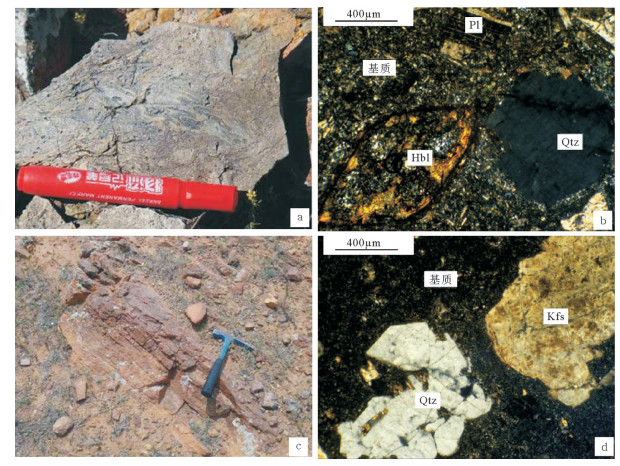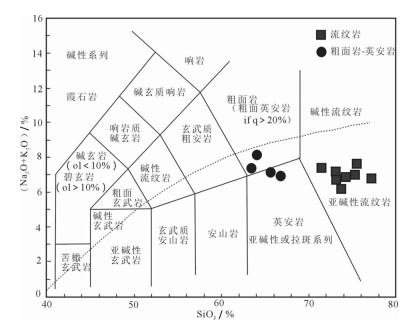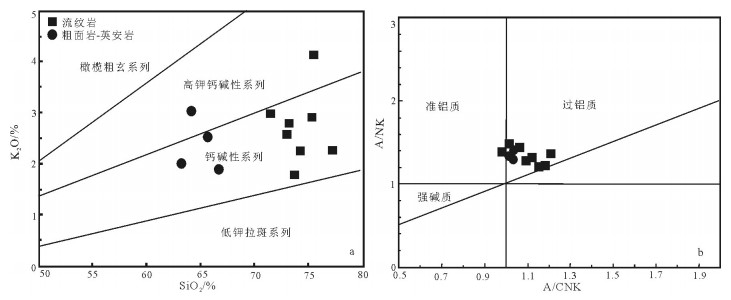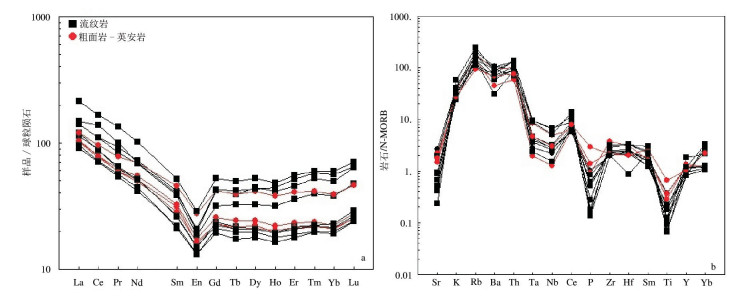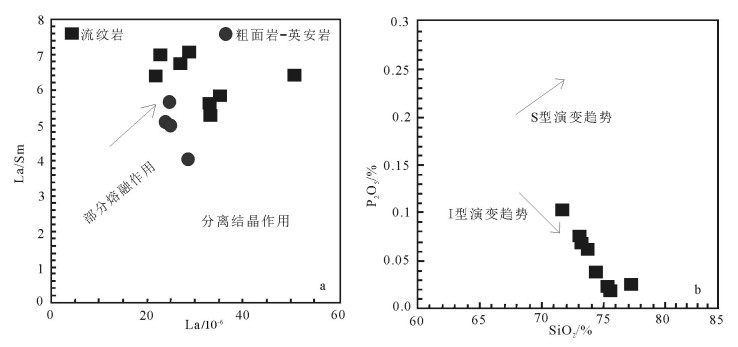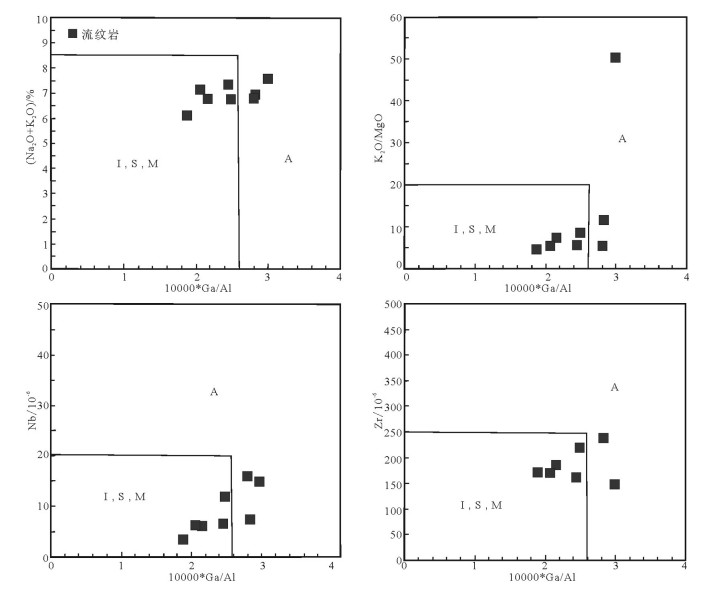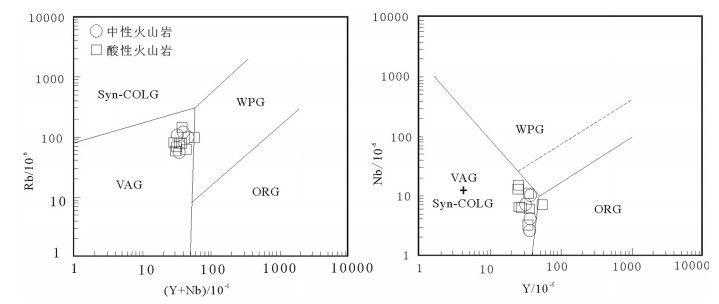The Early Carboniferous volcanic rocks in Engeriyinpeng area of Sonid Left Banner, Inner Mongolia: Discovery and its tectonic significance
-
摘要:
在内蒙古苏尼特左旗恩格日音棚地区新发现一套英安岩、流纹岩及对应的火山碎屑岩组合,测得英安岩LA-ICP-MS锆石U-Pb年龄为333.0±1.4Ma,为早石炭世中期,代表宝力高庙组火山岩的初始喷发年龄。其中多数样品具钙碱性系列特征,在TAS图解中,分别落入流纹岩区和粗面岩-英安岩区;所有样品具相似的微量、稀土元素特征,稀土元素总量中等(∑REE=110.6×10-6~273.3×10-6),轻、重稀土元素分馏明显((La/Yb)N=2.39~5.31),具较弱的负Eu异常(δEu=0.48~0.65)。微量元素以富集大离子亲石元素Rb、Th,亏损高场强元素P、Ti、Nb、Ta为特征,显示岩浆来源为地壳物质的部分熔融,形成于俯冲构造环境。通过区域对比,早石炭世火山岩与贺根山蛇绿岩带北侧二连—东乌旗一带的早石炭世二长花岗岩、石英闪长岩、花岗闪长岩等共同构成了早石炭世与板块俯冲有关的岩浆弧。早石炭世贺根山洋盆开始向北俯冲进入消减阶段。
Abstract:This paper reports newly discovered Early Carboniferous volcanic rocks in Engeriyinpeng area of Sonid Left Banner, Inner Mongolia.LA-ICP-MS U-Pb zircon dating shows that the volcanic rocks has an age of 333.0 ±1.4Ma, which suggests that Baoligaomiao Formation was erupted in Early Carboniferous. Geochemical analysis shows that most of the samples are characterized by calc-alkaline rock series. All the acidic volcanic rocks fall into rhyolite area, two of the neutral volcanic rocks fall into trachyte area, other samples fall into dacite area, and all samples are characterized by alkaline rock series in the TAS diagram. All samples have similar characteristics of REE patterns which are characterized by medium total REE content (∑REE=110.6×10-6~273.3×10-6), significant fractionation of HREE and LREE (La/Yb)N=2.39~5.31) and relatively strong negative Eu anomalies (δEu=0.48~0.65). The trace element geochemistry is characterized evidently by enrichment of LILE (Rb and Th), and strong depletion of HFSE (P, Ti, Nb and Ta). The ratios of Rb/Sr (0.50~6.64), Ti/Y (6.82~85.21) and Ti/Zr (2.27~19.71) all fall into the field of the earth's crust source. These characteristics indicate that the volcanic rocks might have originated from partial melting of the earth's crust, and they were formed in a subduction-related settings. Combined with the regional researching results and the previous research results, the authors hold that the Carboniferous volcanic rocks, together with other Early Carboniferous arc-related felsic magmatic rocks in the Erlianhot-Dongwu Banner region, constitute the magmatic arc caused by the northward subduction of Hegenshan Ocean.
-
致谢: 感谢审稿专家及中国地质调查局发展研究中心张明超博士对本文提出的宝贵修改意见和建议,感谢天津地质调查中心实验测试室及耿建珍老师等工作人员对锆石U-Pb同位素年龄测试提供的支持。
-
图 1 内蒙古苏尼特左旗恩格日音棚地区大地构造位置(a,据参考文献[8]修改)和区域地质简图(b)
1—正断层;2—地层及岩体侵入界线;3—角度不整合界线;4—产状;5—采样位置及样品号;6—实测剖面位置;7—研究区位置;Q—第四系洪冲积物;C1bl—上石炭统宝力高庙组;D1-2n2—中下泥盆统泥鳅河组;ξγxC1—早石炭世细粒正长花岗岩;ηγx C1—早石炭世二长花岗岩
Figure 1. Tectonic location map (a) and geological sketch map (b) of the Engeriyinpeng area in Inner Mongolia
图 5 早石炭世火山岩TAS图解(底图据参考文献[44])
Figure 5. TAS diagram of Early Carboniferous volcanic rocks
图 7 早石炭世火山岩球粒陨石标准化稀土元素图解(a)和微量元素蛛网图(b)(标准化值据参考文献[46])
Figure 7. Chondrite-normalized REE (a) and primary mantle-normalized trace element spider diagrams (b) for Early Carboniferous volcanic rocks
图 9 花岗岩类判别图(底图据参考文献[53])
A—A型花岗岩;I—I型花岗岩;S—S型花岗岩;M—M型花岗岩
Figure 9. Classification diagrams of granitoid
图 10 早石炭世火山岩构造环境判别图[68]
Syn-COLG—同碰撞花岗岩;WPG—板内花岗岩;VAG—火山弧花岗岩;ORG—洋脊花岗岩
Figure 10. Tectonic discrimination diagrams of the volcanic rocks
图 11 早石炭世中期区域构造模式[67]
Figure 11. The regional tectonic pattern of Early Middle Carboniferous
表 1 早石炭世英安岩LA-ICP-MS锆石U-Th-Pb同位素数据
Table 1 LA-ICP-MS zircon U-Th-Pb data of dacite from early Carboniferous volcanic rocks
样品测点 含量/10-6 同位素比值 年龄/Ma Pb U Th 232Th/238U 1σ 206Pb/238U 1σ 207Pb/235U 1σ 207Pb/206Pb 1σ 208Pb/232Th 1σ 206Pb/238U 1σ 1.1 42 755 281 0.3821 0.0013 0.0533 0.0002 0.4212 0.0060 0.0573 0.0008 0.022 0.0007 335 3 2.1 26 470 229 0.5004 0.0005 0.0534 0.0002 0.3940 0.0082 0.0535 0.0011 0.0161 0.0005 335 3 3.1 61 1113 440 0.4057 0.0016 0.0528 0.0002 0.4008 0.0051 0.0550 0.0007 0.0178 0.0005 332 3 4.1 51 1075 515 0.4920 0.0007 0.0439 0.0002 0.4023 0.0052 0.0665 0.0008 0.0161 0.0005 277 2 5.1 80 1151 853 0.7604 0.0021 0.0522 0.0002 0.4009 0.0062 0.0557 0.0008 0.0326 0.0010 328 3 6.1 48 899 459 0.5239 0.0008 0.0534 0.0002 0.3918 0.0056 0.0532 0.0007 0.0100 0.0003 336 3 7.1 31 532 416 0.8037 0.0036 0.0537 0.0002 0.4047 0.0076 0.0547 0.0010 0.0120 0.0005 337 3 8.1 24 436 257 0.6036 0.0007 0.0533 0.0002 0.3895 0.0091 0.0530 0.0012 0.0107 0.0005 335 3 9.1 35 654 327 0.5128 0.0035 0.0534 0.0002 0.4039 0.0095 0.0549 0.0013 0.0112 0.0005 335 3 10.1 8 148 53 0.3647 0.0010 0.0523 0.0002 0.3973 0.0216 0.0551 0.0030 0.0126 0.0007 329 4 11.1 47 885 429 0.4969 0.0009 0.0538 0.0002 0.4006 0.0086 0.0540 0.0011 0.0100 0.0004 338 3 12.1 49 856 561 0.6728 0.0010 0.0531 0.0002 0.3727 0.0061 0.0509 0.0008 0.0160 0.0005 334 3 13.1 34 612 351 0.5879 0.0035 0.0531 0.0002 0.3504 0.0076 0.0478 0.0010 0.0146 0.0004 334 3 14.1 56 1017 477 0.4812 0.0010 0.0530 0.0002 0.3591 0.0061 0.0491 0.0009 0.0174 0.0005 333 3 15.1 75 1135 724 0.6542 0.0015 0.0527 0.0002 0.3603 0.0056 0.0496 0.0007 0.0320 0.0009 331 3 16.1 30 548 275 0.5147 0.0004 0.0530 0.0002 0.3610 0.0073 0.0494 0.0009 0.0143 0.0004 333 3 17.1 45 757 385 0.5209 0.0016 0.0534 0.0002 0.3670 0.0051 0.0499 0.0006 0.0246 0.0007 335 3 18.1 24 472 205 0.4448 0.0004 0.0514 0.0002 0.3706 0.0215 0.0522 0.0030 0.0128 0.0004 323 3 19.1 30 565 269 0.4876 0.0003 0.0527 0.0002 0.3703 0.0078 0.0510 0.0011 0.0138 0.0003 331 3 20.1 20 404 186 0.4724 0.0009 0.0471 0.0002 0.3914 0.0103 0.0603 0.0016 0.0130 0.0003 297 2 21.1 26 463 250 0.5543 0.0011 0.0533 0.0002 0.4105 0.0134 0.0559 0.0017 0.0150 0.0004 335 3 22.1 21 372 259 0.7136 0.0016 0.0528 0.0002 0.4016 0.0094 0.0552 0.0013 0.0121 0.0003 332 3 23.1 36 623 295 0.4858 0.0026 0.0529 0.0002 0.3931 0.0071 0.0539 0.0009 0.0206 0.0005 332 3 24.1 34 611 266 0.4472 0.0012 0.0527 0.0002 0.3905 0.0087 0.0537 0.0011 0.0192 0.0005 331 3 25.1 62 1011 653 0.6625 0.0037 0.0495 0.0002 0.4033 0.0049 0.0591 0.0007 0.0271 0.0008 311 3 26.1 150 2266 1312 0.5938 0.0007 0.0410 0.0007 1.7343 0.0197 0.3069 0.0034 0.0384 0.0012 259 2 表 2 早石炭世火山岩地球化学分析结果
Table 2 Geochemical composition of early Carboniferous volcanic rocks
样品号 TW-1 TW-2 TW-3 TW-4 TW-5 TW-6 TW-7 TW-8 TW-9 TW-10 TW-11 TW-12 SiO2 66.79 73.76 75.34 64.18 65.73 74.33 73.22 73.10 71.57 63.36 77.22 75.58 Al2O3 15.23 12.57 12.82 16.03 14.75 12.70 12.86 13.25 14.05 14.34 11.85 12.25 Fe2O3 1.37 1.38 1.14 1.59 1.80 1.72 1.89 1.46 2.33 4.20 1.46 1.14 FeO 1.95 0.75 0.56 2.07 1.95 0.44 0.44 0.68 0.20 2.58 0.60 1.59 CaO 2.57 2.05 0.89 2.12 1.97 0.91 1.64 1.40 0.65 1.84 0.23 0.13 MgO 0.95 0.40 0.25 1.90 2.62 0.43 0.37 0.49 0.54 1.75 0.27 0.082 Na2O 5.06 4.37 4.05 5.06 4.60 4.58 3.96 4.53 4.37 5.26 4.49 3.42 K2O 1.88 1.77 2.90 3.02 2.51 2.24 2.79 2.57 2.98 1.98 2.26 4.14 TiO2 0.36 0.16 0.12 0.48 0.46 0.15 0.26 0.23 0.28 0.84 0.083 0.090 P2O5 0.16 0.060 0.018 0.12 0.11 0.032 0.067 0.072 0.10 0.34 0.021 0.016 MnO 0.074 0.038 0.018 0.055 0.076 0.077 0.047 0.045 0.20 0.13 0.015 0.016 烧失量 3.37 2.22 1.37 2.92 2.76 1.92 1.83 1.63 2.25 2.95 1.31 1.13 总量 99.79 99.54 99.51 99.58 99.37 99.53 99.39 99.47 99.52 99.61 99.82 99.61 A/CNK 1.01 0.98 1.12 1.04 1.06 1.09 1.03 1.04 1.21 1.01 1.16 1.18 Y 37.6 33.1 51.4 34.5 34.4 23.2 32.5 27.1 23.6 29.1 33.0 23.0 Ga 15.8 12.6 19.2 20.1 20.0 18.9 14.7 14.5 18.2 16.1 15.6 19.4 Rb 80.4 77.4 93.4 117 101 78.8 101 58.6 80.3 74.2 62.4 140 Nb 2.92 3.50 7.45 5.17 11.6 15.9 6.05 6.38 6.61 7.10 12.0 15.1 Ta 0.26 0.31 0.62 0.38 1.12 1.26 0.48 0.58 0.53 0.61 1.17 1.25 Th 7.09 10.6 15.9 11.0 12.2 10.9 12.4 11.0 8.23 9.18 16.7 16.2 Ba 283 192 645 683 602 373 451 427 590 407 445 525 Co 6.20 2.38 1.59 9.25 14.9 3.42 3.49 3.25 6.10 13.3 2.53 2.42 Cr 14.6 6.17 7.17 34.9 86.5 7.10 8.09 11.6 11.8 13.5 14.3 7.77 Ni 3.79 3.08 3.65 13.6 52.8 6.04 6.86 5.67 10.5 6.69 9.00 4.02 Sr 132 84.4 80.3 230 201 36.9 83.8 61.3 160 145 46.4 21.1 V 56.8 13.8 6.51 74.7 82.2 7.04 23.6 18.3 34.6 108 12.5 6.76 Sc 8.72 5.53 4.97 11.5 11.4 4.90 4.31 3.69 4.55 12.6 3.12 2.38 Zr 175 173 236 146 278 240 186 170 161 161 219 148 Hf 4.18 4.92 6.78 4.93 6.41 6.82 5.23 4.94 4.44 4.19 6.55 1.78 La 24.8 27.0 33.0 24.1 24.3 33.1 28.6 22.6 21.6 28.3 50.7 35.1 Ce 48.0 53.7 67.5 47.0 48.3 67.4 52.9 43.5 43.1 58.6 102 84.8 Pr 5.90 5.93 7.95 5.67 5.58 8.69 6.11 5.32 5.10 7.34 12.7 9.48 Nd 25.7 24.0 31.9 23.9 23.0 33.6 23.8 20.8 19.3 32.2 47.2 32.3 Sm 4.95 4.00 5.89 4.74 4.31 6.31 4.05 3.22 3.37 7.01 7.91 6.05 Eu 1.02 0.86 1.07 0.92 0.95 1.15 0.87 0.76 0.77 1.60 1.66 1.20 Gd 5.28 4.85 6.54 4.73 4.70 8.63 4.60 4.32 3.98 8.61 10.7 8.73 Tb 0.91 0.81 1.22 0.78 0.80 1.45 0.78 0.73 0.65 1.45 1.86 1.56 Dy 6.14 5.30 8.29 5.31 5.65 11.2 5.25 4.99 4.54 10.5 13.3 11.0 Ho 1.24 1.09 1.78 1.14 1.09 2.35 1.09 1.00 0.93 2.15 2.73 2.50 Er 3.84 3.56 5.91 3.52 3.42 7.52 3.42 3.13 2.93 6.76 9.14 8.60 Tm 0.60 0.57 1.01 0.56 0.55 1.34 0.56 0.51 0.50 1.06 1.52 1.48 Yb 3.79 3.87 6.48 3.54 3.60 8.43 3.61 3.37 3.23 6.68 10.1 9.50 Lu 0.70 0.74 1.21 0.64 0.64 1.61 0.67 0.61 0.61 1.18 1.80 1.64 ∑REE 132.9 136.3 179.8 126.55 126.89 192.78 136.31 114.86 110.6 173.4 273.3 213.9 (La/Yb)N 4.23 4.51 3.30 4.41 4.37 2.54 5.13 4.34 4.33 2.74 3.25 2.39 δEu 0.61 0.6 0.53 0.59 0.65 0.48 0.62 0.63 0.65 0.63 0.56 0.51 注:主量元素含量单位为%,微量和稀土元素含量为10-6;TW-1:英安岩;TW-2:流纹岩;TW-3:流纹岩;TW-4:英安岩;TW-5:英安质晶屑凝灰岩;TW-6~TW-9:流纹岩;TW-10:英安质晶屑凝灰岩;TW-11~TW-12:流纹岩 -
Kovalenko V I, Yarmolyuk V V, Kovach V P, et al. Isotope provinces, mechanisms of generation and sources of the continental crust in the Central Asian mobile belt:geological and isotopic evidence[J]. Journal of Asian Earth Sciences, 2004, 23(5):605-627. doi: 10.1016/S1367-9120(03)00130-5
Windley B F, Alexeiev D, Xiao W, et al. Tectonic models for accretion of the Central Asian Orogenic Belt[J]. Journal of the Geological Society, 2007, 164(12):31-47. http://www.wanfangdata.com.cn/details/detail.do?_type=perio&id=407c8a0b623113b1dd6b69ee8fde6a21
Jahn B M, Windley B, Natal'In B, et al. Phanerozoic continental growth in Central Asia[J]. Journal of Asian Earth Sciences, 2004, 23(5):599-603. doi: 10.1016/S1367-9120(03)00124-X
郭锋, 范蔚茗, 李超文, 等.早古生代古亚洲洋俯冲作用:来自内蒙古大石寨玄武岩的年代学与地球化学证据[J].中国科学(D辑), 2009, (5):569-579. http://d.old.wanfangdata.com.cn/Periodical/ysxb98201501007 邵济安.中朝板块北缘中段地壳演化[M].北京:北京大学出版社, 1991. 唐克东.中朝板块北侧褶皱带构造演化及成矿规律[M].北京:北京大学出版社, 1992. Bei X, Chen B. Framework and evolution of the middle Paleozoic orogenic belt between Siberian and North China Plates in northern Inner Mongolia[J]. Science in China (Series D), 1997, 40(5):463-469. doi: 10.1007/BF02877610
Xiao W, Windley B F, Hao J, et al. Accretion leading to collision and the Permian Solonker suture, Inner Mongolia, China:Termination of the central Asian orogenic belt[J]. Tectonics, 2003, 22(6):1-20.
Chen C, Zhang Z C, Guo ZJ, et al. Geochronology, geochemistry, and its geological significance of the Permian Mandula mafic rocks in Damaoqi, Inner Mongolia[J]. Science in China (Series D), 2012, 55(1):39-52. doi: 10.1007/s11430-011-4277-z
Xu B, Charvet J, Chen Y, et al. Middle Paleozoic convergent orogenic belts in western Inner Mongolia (China):framework, kinematics, geochronology and implications for tectonic evolution of the Central Asian Orogenic Belt[J]. Gondwana Research, 2013, 23(4):1342-1364. doi: 10.1016/j.gr.2012.05.015
Xu M A, Chen B, Chen J F, et al. Zircon SHRIMP U-Pb age, geochemical, Sr-Nd isotopic, and in-situ Hf isotopic data of the Late Carboniferous-Early Permian plutons in the northern margin of the North China Craton[J]. Science in China (Series D), 2013, 56(1):126-144. doi: 10.1007/s11430-012-4456-6
Shi G, Faure M, Xu B, et al. Structural and kinematic analysis of the Early Paleozoic Ondor Sum-Hongqi mélange belt, eastern part of the Altaids (CAOB) in Inner Mongolia, China[J]. Journal of Asian Earth Sciences, 2013, 66(5):123-139.
Wen Z, Wu T R, Feng J C, et al. Time constraints for the closing of the Paleo-Asian Ocean in the Northern Alxa Region:Evidence from Wuliji granites[J]. Science in China (Series D), 2013, 56(1):153-164. doi: 10.1007/s11430-012-4435-y
Zhang Z, Li K, Li J, et al. Geochronology and geochemistry of the Eastern Erenhot ophiolitic complex:Implications for the tectonic evolution of the Inner Mongolia-Daxinganling Orogenic Belt[J]. Journal of Asian Earth Sciences, 2015, 97:279-293. doi: 10.1016/j.jseaes.2014.06.008
Xiao W J, Windley B F, Huang B C, et al. End-Permian to Mid-Triassic termination of the accretionary processes of the southern Altaids:Implications for the geodynamic evolution, Phanerozoic continental growth, and metalloteny of central Asia[J]. International Journal of Earth Sciences, 2009, 98(6):1189-1217 doi: 10.1007/s00531-008-0407-z
Li J Y. Permian geodynamic setting of Northeast China and adjacent regions:closure of the Paleo-Asian Ocean and subduction of the Paleo-Pacific Plate[J]. Journal of Asian Earth Sciences, 2006, 26(3/4):207-224.
陈斌, 马星华, 刘安坤, 等.锡林浩特杂岩和蓝片岩的锆石U-Pb年代学及其对索仑缝合带演化的意义[J].岩石学报, 2009, 25(12):3123-3129. http://d.old.wanfangdata.com.cn/Periodical/ysxb98200912002 Tang K. Tectonic development of Paleozoic fold belts at the north margin of the Sino-Korean Craton[J]. Tectonics, 1990, 9(2):249-260.
徐备, 陈斌.内蒙古北部华北板块与西伯利亚板块之间中古生代造山带的结构及演化[J].中国科学, 1997, (3):227-232. http://www.wanfangdata.com.cn/details/detail.do?_type=perio&id=QK199700269956 Zhang X H, Zhang H, Tang Y, et al. Geochemistry of Permian bimodal volcanic rocks from central Inner Mongolia, North China:Implication for tectonic setting and Phanerozoic continental growth in Central Asian Orogenic Belt[J]. Chemical Geology, 2008, 249(3):262-281.
Shi G, Miao L, Zhang F, et al. Emplacement age and tectonic implications of the Xilinhot A-type granite in Inner Mongolia, China[J]. Chin. Sci. Bull., 2004, 49(7):723-729. doi: 10.1007/BF03184272
罗红玲, 吴泰然, 赵磊.华北板块北缘乌梁斯太A型花岗岩体锆石SHRIMP U-Pb定年及构造意义[J].岩石学报, 2009, 25(3):515-526. http://d.old.wanfangdata.com.cn/Periodical/ysxb98200903004 周志广, 谷永昌, 柳长峰, 等.内蒙古东乌珠穆沁旗满都胡宝拉格地区早-中二叠世华夏植物群的发现及地质意义[J].地质通报, 2010, 29(1):21-25. doi: 10.3969/j.issn.1671-2552.2010.01.003 王玉净, 樊志勇.内蒙古西拉木伦河北部蛇绿岩带中二叠纪放射虫的发现及其地质意义[J].古生物学报, 1997, 36(1):58-69. http://www.wanfangdata.com.cn/details/detail.do?_type=perio&id=QK199700131556 王友, 樊志勇, 方曙, 等.西拉木伦河北岸新发现地质资料及其构造意义[J].内蒙古地质, 1999, (1):1-28 樊志勇.内蒙古西拉木伦河北岸杏树洼一带石炭纪洋壳"残片"的发现及其构造意义[J].地质通报, 1996, (4):382. http://www.cnki.com.cn/Article/CJFD1996-ZQYD604.016.htm Chen B, Jahn B M, Wilde S, et al. Two contrasting Paleozoic magmatic belts in northern Inner Mongolia, China:petrogenesis and tectonic implications[J]. Tectonophysics, 2000, 328(1):157-182. doi: 10.1016-S0040-1951(00)00182-7/
Chen B, Jahn B M, Tian W. Evolution of the Solonker suture zone:Constraints from zircon U-Pb ages, Hf isotopic ratios and whole-rock Nd-Sr isotope compositions of subduction- and collision-related magmas and forearc sediments[J]. Journal of Asian Earth Sciences, 2009, 34(3):245-257. doi: 10.1016/j.jseaes.2008.05.007
张臣, 吴泰然.内蒙古苏左旗南部华北板块北缘中新元古代-古生代裂解-汇聚事件的地质记录[J].岩石学报, 2001, 17(2):199-205. http://d.old.wanfangdata.com.cn/Periodical/ysxb98200102003 陈斌, 赵国春, Wilde S A.内蒙古苏尼特左旗南两类花岗岩同位素年代学及其构造意义[J].地质论评, 2001, 47(4):361-367. doi: 10.3321/j.issn:0371-5736.2001.04.005 Shi G, Miao L, Zhang F, et al. Emplacement age and tectonic implications of the Xilinhot A-type granite in Inner Mongolia, China[J]. Chin. Sci. Bull., 2004, 49(7):723-729. doi: 10.1007/BF03184272
石玉若, 刘敦一, 张旗, 等.内蒙古苏左旗地区闪长-花岗岩类SHRIMP年代学[J].地质学报, 2004, 78(6):789-799. doi: 10.3321/j.issn:0001-5717.2004.06.009 李锦轶, 高立明, 孙桂华, 等.内蒙古东部双井子中三叠世同碰撞壳源花岗岩的确定及其对西伯利亚与中朝古板块碰撞时限的约束[J].岩石学报, 2007, 23(3):565-582. http://d.old.wanfangdata.com.cn/Periodical/ysxb98200703004 Miao L, Fan W, Liu D, et al. Geochronology and geochemistry of the Hegenshan ophiolitic complex:Implications for late-stage tectonic evolution of the Inner Mongolia-Daxinganling Orogenic Belt, China[J]. Journal of Asian Earth Sciences, 2008, 32(5/6):348-370.
童英, 洪大卫, 王涛, 等.中蒙边境中段花岗岩时空分布特征及构造和找矿意义[J].地球学报, 2010, 31(3):133-150. http://d.old.wanfangdata.com.cn/Periodical/dqxb201003013 李可, 张志诚, 冯志硕, 等.内蒙古中部巴彦乌拉地区晚石炭世-早二叠世火山岩锆石SHRIMP U-Pb定年及其地质意义[J].岩石学报, 2014, 30(7):2041-2054. http://d.old.wanfangdata.com.cn/Conference/8159504 Zhang S H, Zhao Y, Song B, et al. Carboniferous granitic plutons from the northern margin of the North China block:implications for a late Paleozoic active continental margin. J Geol Soc Lond[J]. Journal of the Geological Society, 2007, 164(2):451-463. doi: 10.1144/0016-76492005-190
Wu F Y, Zhao G C, Sun D Y, et al. The Hulan Group:its role in the evolution of the Central Asian Orogenic Belt of NE China[J]. J. Asian Earth Sci., 2007, 30:542-556。 doi: 10.1016/j.jseaes.2007.01.003
黄金香, 赵志丹, 张宏飞, 等.内蒙古温都尔庙和巴彦敖包-交其尔蛇绿岩的元素与同位素地球化学:对古亚洲洋东部地幔域特征的限制[J].岩石学报, 2006, 22(12):2889-2900. http://d.old.wanfangdata.com.cn/Periodical/ysxb98200612007 Jian P, Kröner A, Windley B F, et al. Carboniferous and Cretaceous mafic-ultramafic massifs in Inner Mongolia (China):A SHRIMP zircon and geochemical study of the previously presumed integral"Hegenshan ophiolite"[J]. Lithos, 2012, s142/143:48-66.
辛后田, 滕学建.内蒙古东乌旗宝力高庙组地层划分及其同位素年代学研究[J].地质调查与研究, 2011, 34(1):1-9. doi: 10.3969/j.issn.1672-4135.2011.01.001 Ludwig K R. User's manual for Isoplot/Ex:A geochronological toolkit for Microsoft Excel[J]. Berkeley Geochronology Center Special Publication, 2003, 4:1-71. doi: 10.1016-j.immuni.2011.10.010/
Belousova E, Griffin W, O'Reilly S Y, et al. Igneous zircon:trace element composition as an indicator of source rock type[J]. Contributions to Mineralogy & Petrology, 2002, 143(5):602-622.
Maitre R W L. Igneous Rocks:A Classification and Glossary of Terms[M]. Cambridge University Press, 2009, 1(70):93-120.
Peccerillo A, Taylor S R. Geochemistry of Eocene calc-alkaline volcanic rocks from the Kastamonu area, Northern Turkey[J]. Contributions to Mineralogy & Petrology, 1976, 58(1):63-81. doi: 10.1007-BF00384745/
Sun S S, Mcdonough W F. Chemical and isotopic systematics of oceanic basalts:implications for mantle composition and processes[J]. Geological Society London Special Publications, 1989, 42(1):313-345. doi: 10.1144/GSL.SP.1989.042.01.19
内蒙古自治区地质矿产局.内蒙古自治区区域地质志[M].北京:地质出版社, 1991. 内蒙古自治区地质矿产局.内蒙古自治区岩石地层[M].武汉:中国地质大学出版社, 1996. 李文国.宝力格组的时代问题辨[J].地层学杂志, 1981, (1):48-51. http://www.cnki.com.cn/Article/CJFDTOTAL-DCXZ198101006.htm Zhang X H, Wilde S A, Zhang H F, et al. Early Permian high-K aclc-alkaline volcanic rocks from NW Inner Mongolia, North China:Geochemistry, orign and tectonic implications[J]. Journal of Geological Society, 2011, 168(2):525-543. doi: 10.1144/0016-76492010-094
Tischendorf G, Paelchen W. Zur Klassifikation von Granitoiden/Classification of granitoid[J]. Zeitschrife fuer Geologische Wissenschaften, 1985, 13(5):615-627.
韩宝福.后碰撞花岗岩类的多样性及其构造环境判别的复杂性[J].地学前缘, 2007, 14(3):64-72. doi: 10.3321/j.issn:1005-2321.2007.03.006 Whalen J B, Currie K L, Chappell B W. A-type granites:geochemical characteristics, discrimination and petrogenesis[J]. Contributions to Mineralogy & Petrology, 1987, 95(4):407-419. http://d.old.wanfangdata.com.cn/Periodical/hndzykc201103007
赵振华.稀土元素地球化学研究方法[J].地球与环境, 1982, (1):28-35. http://cdmd.cnki.com.cn/Article/CDMD-10674-1011057516.htm Collins W J, Beams S D, White A J R, et al. Nature and origin of A-type granites with particular reference to southeastern Australia[J]. Contributions to Mineralogy & Petrology, 1982, 80(2):189-200.
汤文豪, 张志诚, 李建锋, 等.内蒙古苏尼特右旗查干诺尔石炭系本巴图组火山岩地球化学特征及其地质意义[J].北京大学学报(自然科学版), 2011, 47(2):321-330. http://www.wanfangdata.com.cn/details/detail.do?_type=perio&id=bjdxxb201102020 陶继雄, 白立兵, 宝音乌力吉, 等.内蒙古满都拉地区二叠纪俯冲造山过程的岩石记录[J].地质调查与研究, 2003, 26(4):241-249. doi: 10.3969/j.issn.1672-4135.2003.04.008 卿敏, 唐明国, 葛良胜, 等.内蒙古苏右旗毕力赫金矿区安山岩LA-ICP-MS锆石U-Pb年龄、元素地球化学特征及其形成的构造环境[J].岩石学报, 2012, 28(2):160-170. http://d.old.wanfangdata.com.cn/Periodical/ysxb98201202013 张万益, 聂凤军, 江思宏, 等.内蒙古查干敖包石英闪长岩锆石SHRIMP U-Pb年龄及其地质意义[J].岩石矿物学杂志, 2008, 27(3):177-184. doi: 10.3969/j.issn.1000-6524.2008.03.002 刘建峰, 迟效国, 张兴洲, 等.内蒙古西乌旗南部石炭纪石英闪长岩地球化学特征及其构造意义[J].地质学报, 2009, 83(3):365-376. http://d.old.wanfangdata.com.cn/Periodical/dizhixb200903006 李可, 张志诚, 冯志硕, 等.兴蒙造山带中段北部晚古生代两期岩浆活动及其构造意义[J].地质学报, 2015, 89(2):272-288. http://d.old.wanfangdata.com.cn/Periodical/dizhixb201502006 薛怀民, 郭利军, 侯增谦, 等.中亚-蒙古造山带东段的锡林郭勒杂岩:早华力西期造山作用的产物而非古老陆块——锆石SHRIMP U-Pb年代学证据[J].岩石学报, 2009, 25(8):640-650. http://d.old.wanfangdata.com.cn/Periodical/ysxb98200908023 张拴宏, 赵越, 刘健, 等.华北地块北缘晚古生代-中生代花岗岩体侵位深度及其构造意义[J].岩石学报, 2007, 23(3):625-638. http://d.old.wanfangdata.com.cn/Periodical/ysxb98200703010 王挽琼.华北板块北缘中段晚古生代构造演化: 温都尔庙-集宁火成岩年代学、地球化学的制约[D].吉林大学博士学位论文, 2014: 1-196. 张金凤, 白新会.内蒙古苏尼特右旗温都尔庙地区早石炭世火山岩的发现及其构造意义[J].岩石学报, 2016, 32(9):2780-2792. http://d.old.wanfangdata.com.cn/Periodical/ysxb98201609013 杨俊泉, 张素荣, 刘永顺, 等.内蒙古东乌旗莫合尔图石炭纪闪长岩的发现:来自锆石U-Pb年代学的证据[J].现代地质, 2014, (3):472-477. doi: 10.3969/j.issn.1000-8527.2014.03.003 肖中军, 王振强, 赵春勇, 等.内蒙古苏尼特左旗北部阿登锡勒大队一带早石炭世高分异I型花岗岩的发现及地质意义[J].地质论评, 2015, 61(4):777-786. http://www.cnki.com.cn/Article/CJFDTOTAL-DZLP201504008.htm Pearce J A, Harris N B W, Tindle A G. Trace Element Discrimination Diagrams for the Tectonic Interpretation of Granitic Rocks[J]. Journal of Petrology, 1984, 25(4):956-983. doi: 10.1093/petrology/25.4.956
内蒙古自治区地质调查院. 1: 25万(巴音乌拉幅)区域地质调查报告. 2007. 河北省区域地质矿产调查研究所.内蒙古1: 5万达如嘎呼都格(1/2)(L49E018017)、乌兰善图音呼都格(1/2)(L49E018018)、德林呼都格(L49E019017)、陶木伊勒特(L49E019018)、红格尔公社(L49E020017)、哈拉图音苏吉幅(L49E020018)区调报告. 2014. 中国地质大学(武汉).内蒙古1: 5万杭嘎拉土乌拉幅(1/2) (L50E015008)、绥和查干边防站幅(3/4)、(L50E016007)、阿拉坦合力大队幅(L50E016008)、阿拉坦合力公社幅(L50E017007)、勒果多瓜勒幅(L50E017008)区调报告. 2012.



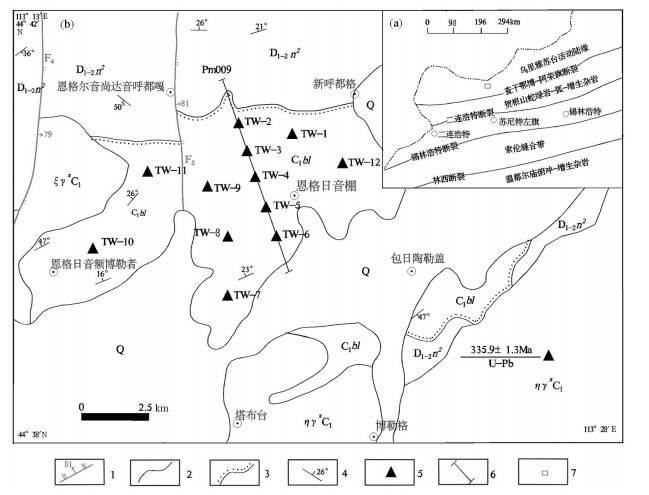
 下载:
下载:
